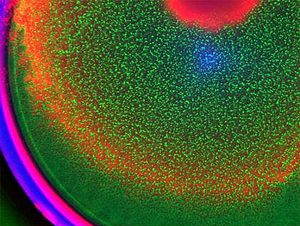How do organs such as the heart or kidneys know when to stop growing? A number of theories have been proposed to answer this, the most entrenched of which dating back from 1952, when the infamous Alan Turing used math to show how biological cell patterns form and how these knew when to stop division. Turing envisioned that the cells knew when to stop growing based on their concentration in a certain location. Researchers at Duke University designed a gene circuit to coax bacteria to grow in a predictable ring pattern. Their findings suggest that the bacteria can sense their environment and that the engineered gene circuit functions as a timing mechanism. Counter to established theories, the findings may have profound implications in biotechnology.

The team of researchers were led by associate professor of biomedical engineering Lingchong You.
“Everywhere you look in nature there are patterns, many of them very beautiful and even inspirational,” said You. “Our work adds another dimension to the general principles of pattern formation.”
Alan Turing was very fascinated about pattern formations in nature and fractals. The scientist was a particularly gifted mathematician with a keen eye for patterns. It’s worth noting, that Turing, among other scientific contributions of invaluable worth (Turing machine), was the man who broke the Nazi Enigma code, shortening WWII. Unfortunately, Turing was disgraced by his home country due to his sexual orientation, fact that led to his regrettable suicide.
Nevertheless, Turing’s legacy with biological patterns still lives on. In the 1950’s, he imagined that biological patterns are formed due to interactions of certain chemicals he called “morphogens” that initiated and directed patterns by triggering on- or off-switches. Using math, Turing showed that morphogens could move in space, revealing patterns that mimic those seen in animal skins and leaf shapes. His model became the de facto leading theory regarding biological pattern formation.
A new dimension to bio-pattern growth: time
After using molecular biology lab techniques, however, You and colleagues were unable to replicate a biological pattern predicted by Turing’s model. The Duke researchers engineered a version of the favored lab pet bacteria, E. Coli, to produce two molecules. One serving as the “on” switch promoting colony growth and replication, and the other acting as an “off” switch that halted growth prompted by increase concentration of “on” molecules.
To better analyze colony growth and pattern formation, the researchers also engineered the bacteria to produce fluorescent colours. The ensuing patterns didn’t behave as the scientists initially predicted, though. Instead, the colonies were much smaller than the research team expected based on how fast the “on” signal should diffuse.
To solve the mystery, the scientists added a high concentration of the “on” signal to the growth chamber, flooding the bacteria with the signal. The bacteria formed the same distinctive ring pattern over the same time, which showed they weren’t responding to changes in the concentration of the “on” signal in space.
The only viable explanation, it seemed, was that the “on” molecules acted as a timing cue. A mathematical model of the timing mechanism was made in order to test this idea. This model predicted how the cells would respond to changes in the size of their growth chamber. This was later confirmed by experiments.
“By serving as a timing cue, the morphogen ‘on’ signal enables the system to sense and respond to the size of the environment,” said You. “The larger the area, the longer it takes for the morphogen to accumulate to a high enough concentration to trigger pattern formation. As such, a larger area will lead to a larger ring pattern.”
Next, the researchers plan on using other gene circuits to create more intricate patterns. Using this technique and armed with new found knowledge on how bio patterns form, scientists could make finely tuned scaffolds for the production of new materials, such as thin metal films for energy applications.
The findings were presented in a paper published in the journal Molecular Systems Biology.


